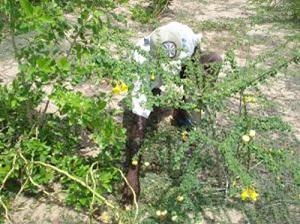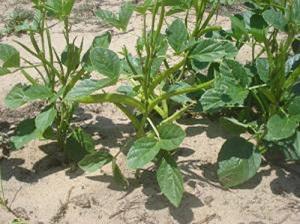Balachandran Natesan
The main aim and objective of this project is to study the possibility of intercropping with vegetables in developing a community forest environment, to increase the income for the poorest poor while conserving the coastal sand dunes with the help of men and woman self help groups.

Gmelina fruit collection- a source for natural shampoo.
Coastal sand dunes are now considered as one of the ‘Critical Habitats’ throughout the world. Along the East coast of Peninsular India especially in Tamilnadu and Puducherry, the lesson learned from the devastation caused by Tsunami (in 2004) was the beginning for most conservation activities in coastal and mangrove ecosystems.

A well growth of Cluster bean
The first and foremost eco-restoration program was started in 2005 at a distance of six km including two fishermen villages, Anumandhai and Chettinagar of Villupuram district in Tamil Nadu, using 80 % of indigenous species and the survival rate to date is nearly 70. Spontaneous growth of tomatoes (Lycopersicon esculentum) and ragi (Eleusine coracana), flowering and fruiting, was encouraged to write this project aiming to cultivate vegetables and maintain a nursery on the beach to generate income for maintaining and extending the plantation beyond the project period.
This exercise will be executed at Nallavadu, is one of the biggest fisherman villages in Union territory of Pondicherry (between latitude 11° 46’ and 12° 03’ N; longitude 76° 36’ and 79° 52’ E) and is located at a distance of 12 kms south from the main town, Puducherry. This village as well as the targeted site is limited by two big water bodies, Bay of Bengal on the east and back water Uppanar River at west. The village is on the sand dune habitat, from 150 m to 400 m wide are adding more beauty as well as threat to the village. Around 2 hectare of temple land belongs to the fisher folk was planned to initiate the study. Selection and planting of native, saline tolerant, economic and ecologically valuable species in dune habitat without disturbing the existing coastal vegetation such as Spinifex littoreus, Ipomoea pes-caprae, Launaea sarmentosa and Cyperus arenarius; and taking care not to disrupt the nesting grounds of sea animals, i.e., planting at right distance and right species from the high tide line.
Select and form groups of women and men, train them to run a sustainable nursery and cultivate different vegetable crops organically by providing basic support for a year or two. From the profits of cultivation a nominal amount will be saved among the groups to extend the community reserve up to the next village. Training, awareness programmes and exposure trips to common people, NGOs, CBOs and school children, etc will wave out the promising results and outputs of this assignment to the neighbouring villages.